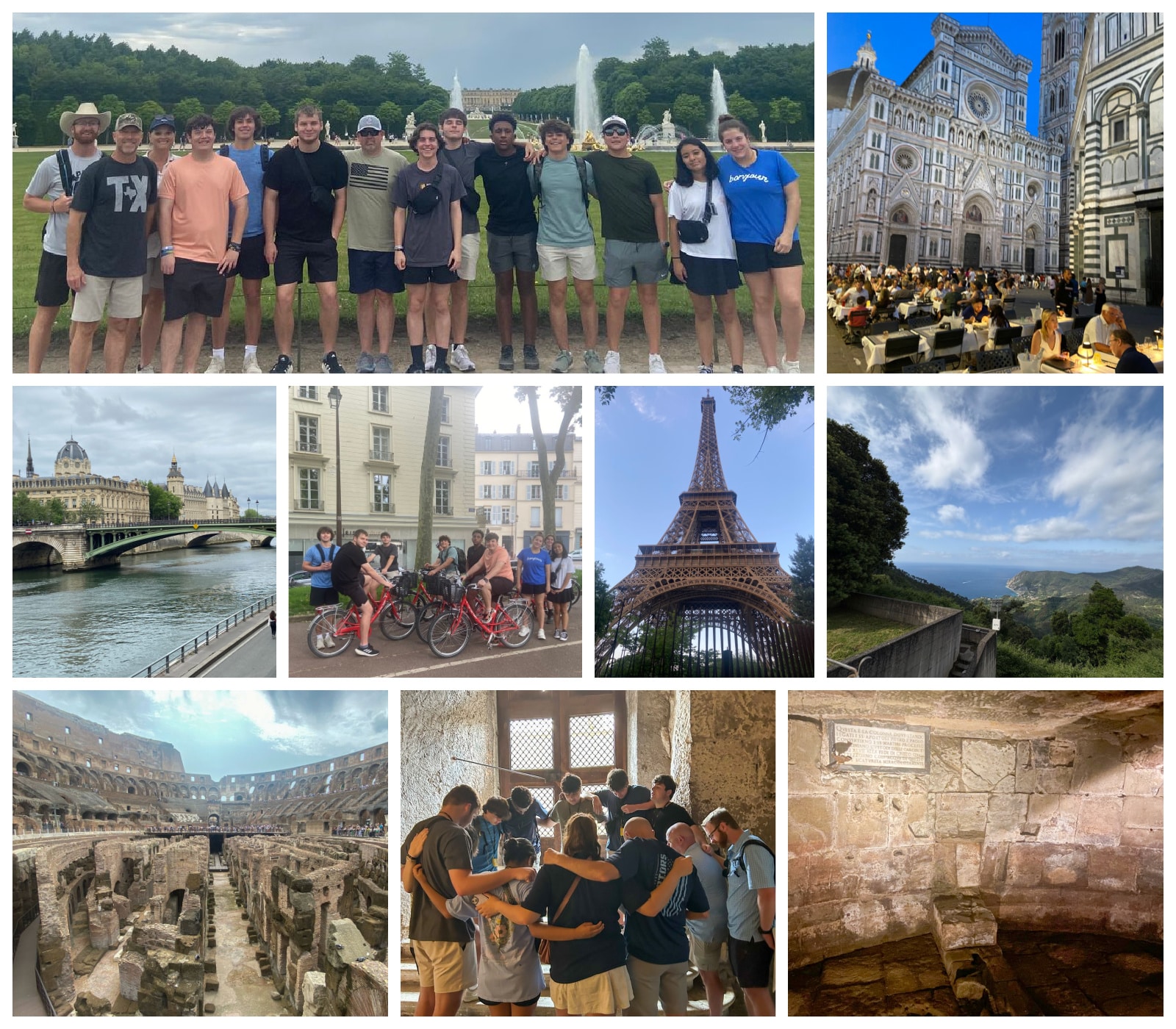From May 25 through June 7, students who had completed SLU 101 and SLU 201 over the last two years embarked on a life-changing trip to England, France and Italy to continue their leadership journey through the CCS Warrior Leadership Academy.
There they stood, the students and their chaperones, staring at the unbelievable architecture of St. Paul’s Cathedral in London. It was the highlight of their day. The cathedral was originally built in 604 A.D. The great Sir Christopher Wren, one of the most gifted architects in not just English history but all history, designed the rebuild and construction after the Great London Fire of 1666. It is a breathtaking building for a believer. To stand inside and look up is to see God’s Word, some of the greatest stonework depicting the great Bible scenes of history, and abundant natural light flooding the entire inner dome. One of the great inspiring statements was when London was devastated by the Blitz in World War II, but on December 29, 1940, as bombs fell all around, a photo was captured of the Cathedral rising above the smoke—untouched. For Londoners, in fact, all of the West, St. Paul’s standing straight and true in the face of terror and fire became a symbol of defiance and courage. Seeing the photo himself and understanding what it wrought in the hearts of his people was more than the Prime Minister could stand. Winston Churchill first went to his war cabinet, and then, his voice was almost yelling and full of passion as he exclaimed on a radio broadcast to his proud nation, “St. Paul’s must be saved at all costs!” We have a proud Christian heritage in the West.
From London, the group headed to Holy Trinity Church in Headington Quarry, Oxford, which has a special place in Christian heritage in England, mainly for its connection to the great C.S. Lewis. Tucked away in a peaceful residential setting, a little east of the center of Oxford, the church is unassuming in size but rich in spiritual legacy. Coach Hogan gave a quick lesson to the students since we had a reservation for just our group to be there alone. If you were to look the church up online, you could see its simple, sacred atmosphere, prioritizing reverence rather than grandeur. That said, it does have beautiful antique lancet windows and a fabulous timbered roof. C.S. Lewis attended church here faithfully each Sunday and sat in a quiet pew near a central pillar—now marked by a small brass plaque. The students rotated through to get a picture in his seat, and the group also visited his gravesite. Interestingly and refreshingly, Lewis chose never to speak formally in church. He attended to worship his Maker, not be seen. Lewis loved his home church for its simplicity and seriousness of worship, the lack of pomp or pretension and his fellow parishioners’ humility and devotion. Coach Hogan has a book titled “The Quotable Lewis” where there is a statement Lewis once made: “The service works on me like a bath or a medicine. I can’t help feeling it—even when I’m not in the mood.” Indeed, it is a church made not for spectacle but for the soul.
The group made their way across the English Channel on an overnight ferry and woke up a stone’s throw from the hallowed grounds of Normandy and the beaches of D-Day. They visited the American Cemetery & Pointe Du Hoc, where a legendary Texan, with his Army Rangers, broke through the German stronghold of machine gun nests. The cemetery allowed our students to perform a wreath-laying ceremony, and over the powerful intercom that reaches the entire grounds, they played our National Anthem & Taps. It was awesome! Coach Seabaugh did a great job on Omaha Beach, sharing about the sacrifice those very young men made that day. When the boats opened, many of them knew instantly they would never make it off that beach, but they charged ANYWAY on behalf of their countrymen and a beautiful future they would never live to see. They laid down their lives for the blessings we are fortunate enough to have had our whole lives. In the message, Coach Seabaugh also shared the Gospel with not only our students but also the group of European strangers curious enough to gather around and see what these Texans were doing! It was beautiful. Many have sacrificed for Christ and Country; we need to be good stewards of both gifts.
A favorite activity was a bike tour in Versailles. The trip included a cool market stop featuring fresh food of seemingly every type, a picnic and a tour of the most influential places, including the palaces and other spectacular architecture. The Treaty of Versailles was signed here, ending World War I, and our two key leadership takeaways that stand out are:
- Do what you ought to do when you ought to do it. This simple principle can lead to a great life. If France had followed it after WWI, Hitler might never have risen to power, and millions could have been spared.
- Values must be defended—or they vanish. Christians are in a culture war whether they choose to be or not. If we fail to stand for our core beliefs—freedom of religion, speech, life, family and God’s design—history shows they will be lost.
As the group moved through Europe, our students received some compliments. For example, upon arrival in Florence, they were greeted by a lady named Stefania. She was their momentary guide. She was thrilled to know we were from Texas. Why? Because her father was a cattle and farm guy who, about 30 years ago, needed to learn more about cattle, so he went to Amarillo, Texas! Stefania went with him and seven other farmers. They flew into the DFW area and into Houston and attended the Houston Livestock Show & Rodeo, where they were absolutely shocked! As soon as she found out they were from Texas, she exclaimed, “I love Texans! They are so nice, so welcoming, so REAL, like us!” It gave Coach Hogan a great lesson to teach our students about leadership and influence: “Even though she didn’t know us, she made assumptions about us because of other Texans.” It’s why Paul, writing to the Corinthians, says, “You are our letter, written in our hearts, known and read by all men; being manifested that you are a letter of Christ, cared for by us, written not with ink but with the Spirit of the living God, not on tablets of stone but on tablets of human hearts.” We are all letters read by all people. There’s an old saying, “It’s important how we live as Christians because our life may be the only Gospel a person reads.”
The group started their first full day in Rome at Mamertine Prison—the grim holding cell where the apostle Paul and Peter were imprisoned on death row. Thrown into a dark, lower chamber through a hole in the floor, they were chained in brutal conditions for two years before execution. While awaiting death, Paul and Peter led fellow prisoners to Christ. Miraculously, water is said to have risen from the prison floor, allowing them to baptize new believers—just days before their martyrdom. The trip leaders walked through that very dungeon with our students, saw the chains and had a time of prayer. It was a humbling experience. This sacred place is where Paul penned some of his final words in 2 Timothy: “I have fought the good fight, I have finished the race, I have kept the faith.”
The Colosseum was as advertised: massive and awe-inspiring. Built to hold crowds that rival modern college football stadiums, construction began around 70 A.D., becoming the stage for gladiator battles, often involving prisoners and exotic animals from around the world. In its first 100 days, over 5,000 animals were slaughtered for entertainment. Many gladiators became popular heroes, even while remaining prisoners. The Colosseum is well known for its many death sentences, including Christian martyrs.
Next, the group visited the Pantheon, originally built in 26 A.D. and rebuilt in 126 A.D. after a fire. It has been in use ever since. Touching the same ancient pillars as people from the second century was awe-inspiring. Think of this: it was built 2,000 years ago and is not only beautifully standing but is still in use! It was built on a flat stone that nature seemed to have provided. The Pantheon is a living testament to Matthew 7: “Everyone then who hears these words of mine and does them will be like a wise man who built his house on the rock. And the rain fell, and the floods came, and the winds blew and beat on that house, but it did not fall, because it had been founded on the rock.”
Finally, the group toured Santo Stefano Rotondo, a fifth-century church dedicated to the first Christian martyr, Stephen. The 34 interior frescoes vividly depict early Christians being killed for their faith. It was deeply sobering and convicting—a reminder to be bold in our walk with Christ. As they left, Hebrews 12 echoed in Coach Hogan’s mind, “Since we are surrounded by so great a cloud of witnesses…let us run with endurance the race set before us.”
This trip was special because the group was able to see the indelible mark of Christianity throughout the incredible history in the West! The leaders were blessed to share this experience with a great group of CCS students!





